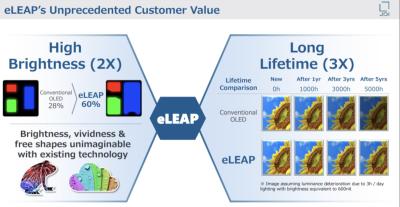In 2022, Japan Display (JDI) announced that it has developed a "historic breakthrough in display technology" - a new OLED deposition process which they refer to as eLEAP, that is said to be cost effective and can be used to create freeform OLEDs that are brighter, more efficient, and longer lasting compared to OLEDs produced using mask evaporation (FMM).
Japan Display announced an agreement with China-based LCD maker HKC Corp to mass produce panels by 2025 in China, based on JDI's technology, but the plan was later cancelled, and JDI said it will establish its own factory in China. The company now says that it is progressing with its negotiations with the Wuhu Economic and Technological Development Zone (in Anhui Province), and the hope is to reach a final agreement will be reached by the end of the year. Interestingly, JDI also says that it is considering building an eLEAP AMOLED fab in India, but we do not have more details.
JDI has started by focusing on adopting eLEAP displays in wearables (as this is its current main AMOLED panel type, which it is supplying to Apple's Watch devices), and has later moved to adapt eLEAP production for use in laptop displays (14-inch displays). The company is producing eLEAP samples in its Japan fab, and it says that the performance exceeds customer expectations. The new fab in China will increase its production volume 50X, when ready in 2025.
Japan Display was established in 2011 by the merger of Sony's, Toshiba's and Hitachi's display businesses and funded by Japan's government fund Innovation Network Corporation (INCJ). The company was late to realize the importance of OLED production and has struggled financially for many years. It announced a strategic focus on OLED displays in 2017, but never managed to gain major mass production capabilities. The company started to produce OLED displays in 2019, but with low volume. It managed to gain Apple as a customer for Watch wearable displays. This new partnership with HKC could be great news for the company, finally gaining access to the vast amounts of money required to mass produce AMOLEDs.
eLEAP is based on a lithographic method, and does not require any masks. The main advantage seems to be that OLED displays produced by eLEAP technology can achieve an aperture ratio of 60%, compared with FMM OLEDs which achieve a ratio of about 28%. This means that the OLED displays can be driven at lower currents - which extends the lifetime, improves the efficiency and also enables higher-peak brightness when needed.
JDI claims that eLEAP displays offer a boost of 2X in emission efficiency and peak brightness - while lifetime is extended by of 3X (which also reduces burn-in problems). These numbers, if accurate, are highly impressive. JDI is using a 300PPI display for these calculations.
eLEAP stands for environment positive, Lithography with maskless deposition, Extreme long life, low power, and high luminance, and Any shape Patterning. JDI says that eLEAP can be combined with the company's HMO (High Mobility Oxide) backplane technology to dramatically improve OLED display performance. eLEAP production technology can be scaled up to 8-Gen (2200x2500 mm) substrates - or even larger, and is suitable for OLED display production from wearable-size displays to TV sizes.

Finally, JDI says that eLEAP reduces operating costs, reduces material waste and does not require cleaning fluids for the masks - which means that eLEAP significantly reduces material usage, waste and CO2 emissions.
In 2022 it was reported that Samsung Display is interested in JDI's eLeap technology, but this wasn't confirmed since then, and later reports suggest at SDC is interested in an exclusive license, which JDI does not wish to provide.




Exceptional innovation, another instance of the oled-info team keeping us up to date on promising new approaches.It will be interesting to see what transpires.